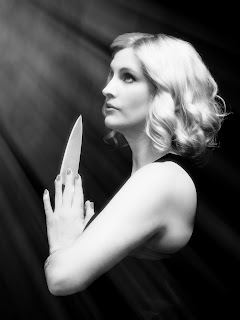 |
| LuckyLu #69 (Prague City Roller Derby) |
A key to reducing stress is to get organized. How much you organize depends on yourself. Some need just a simple guideline or a list while others are fine with in-depth check-lists etc.
Managing pictures
I use Adobe Lightroom to manage/process my pictures. I created a separate catalog for Roller Derby so it doesn't mix with other topics and the amount of pictures is smaller. In general all pictures are contained in date sorted folders grouped by year. I don't have an additional layer for months because events are usually at the weekends so there can be 2 per weekend making it up to round about 100. I cannot attend that much so i have usually 10-12 events per year +extra shootings. That's fine.
Add. Tools
I purchased the ColorChecker Passport from X-Rite to help with colours and white balance. You take pictures with it on location and a) can set the camera white balance directly from the picture with the greycard and b) from the pictures with the colour card a program can create a camera profile later which you can use in Lightroom. I can highly recommend this.
My Workflow
A Derby Bout usually means roundabout 1,000-1,200 pictures. After the import (in which I create 1:1 previews although this takes up to three times longer) I get rid of all out of focus pictures, pictures that show people in unfortunate situations, double/triple shots of the same situation, etc. This usually drops the amount to around 800 pictures.
Next step is to check for the pictures I want to "develop". I create a target collection and add all that catch my eye. This ends up with around 250-300 pictures for a closer look.
If you have set your whitebalance on location you should not have to change anything. If you have just taken a picture of a grey card, use the tool from lightroom to get the colour temperature and set this on all pictures.
Same for the colours. If you have created a profile, apply it to all pictures.
Then business as usual: exposure, crop, straighten, sharpen and at the end maybe apply a personal "look" to your pictures.
I publish directly from Lightroom after I tried to export and upload them normally. It's a step that I can save.
The goal is to get the bout pictures ready as soon as possible. It is not an art project, it is more like a schooltrip and everyone wants pictures quick and after say 2 weeks almost nobody is checking them anymore.
Don't bite off more than you can chew
You should ensure that you can process your pictures in a reasonable amount of time. It may be flattering to get invited to a bout on Saturday and another one on Sunday. But if you don't have the time to get the work done the following week, it might not be a good idea to attend both.
If it isn't a part of the solution it is part of the problem.
Check your gear! Do you take a tripod with you every time? Do you have just one bag for all your shootings? Do you really need that flash/extra lens? Load the batteries, have extra batteries, sync the time if you have more than one camera.
Know your gear! Bringing the lens/camera to a shooting that you received the evening before shooting can cause frustration when the pictures aren't what you want.
Take only the gear that gets the job done! Do not take gear that might be useful like that heavy manual portrait lens or that 600mm zoom you look super-pro with. You are in dark, (sometimes) smelly locations. The track is 18.3 meters long, add maybe 10 more and the longest shot might be 30 meters. That gives you a field of view (full format sensor) of 2.40x1.60 meters. You don't want to shoot portraits across the track, do you?
Don't try to shoot Derby with your f5.6-6.3 Kit lens! You might end up disappointed because the small monitor on your camera might not show enough details to spot blurry pictures right away. I take a f2.8, 24-70, a f2.8, 70-200, a 1.4 or 2.0 converter and a f2.8, 40mm pancake because it weighs almost nothing.
Sometimes an APS-C camera does the job, but a full format DSLR gives you that extra light on the sensor for higher speeds and/or lesser grain.
Simplify the shooting itself
After some spying on a professional photographer (Hello Olivier^^) I use manual exposure settings. Indoor light is more or less stable. Measure once and go with it. I usually start with f3.2, 1/320s, ISO 3200 and adapt. f3.2 gives you nearly 2 meters depth of field at 20 meters distance and 200mm focal length.
I don't recommend AUTO-ISO if it isn't limited. Especially not when using AV or TV settings. You might end up with more grain than you want.
And don't check the camera monitor after each picture. There are more than enough game breaks to go through the recent pictures.
-


